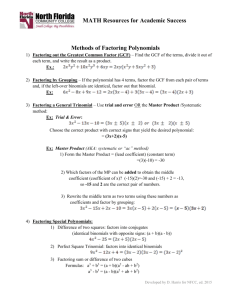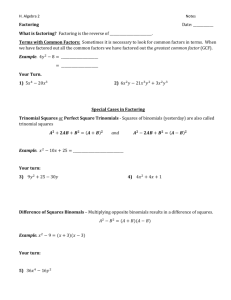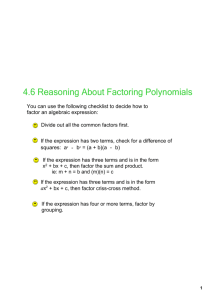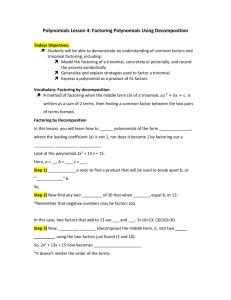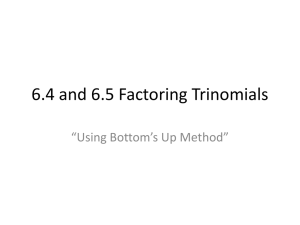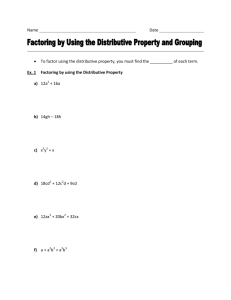Factoring Quadratics
advertisement
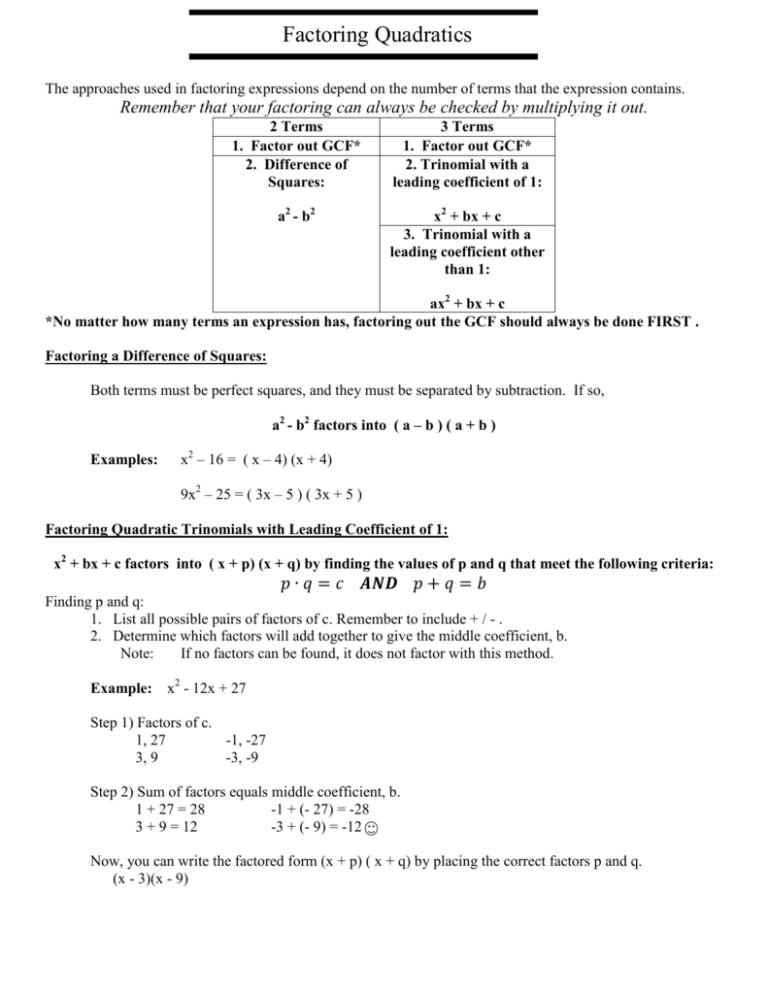
Factoring Quadratics The approaches used in factoring expressions depend on the number of terms that the expression contains. Remember that your factoring can always be checked by multiplying it out. 2 Terms 1. Factor out GCF* 2. Difference of Squares: 3 Terms 1. Factor out GCF* 2. Trinomial with a leading coefficient of 1: a2 - b2 x2 + bx + c 3. Trinomial with a leading coefficient other than 1: ax2 + bx + c *No matter how many terms an expression has, factoring out the GCF should always be done FIRST . Factoring a Difference of Squares: Both terms must be perfect squares, and they must be separated by subtraction. If so, a2 - b2 factors into ( a – b ) ( a + b ) Examples: x2 – 16 = ( x – 4) (x + 4) 9x2 – 25 = ( 3x – 5 ) ( 3x + 5 ) Factoring Quadratic Trinomials with Leading Coefficient of 1: x2 + bx + c factors into ( x + p) (x + q) by finding the values of p and q that meet the following criteria: Finding p and q: 1. List all possible pairs of factors of c. Remember to include + / - . 2. Determine which factors will add together to give the middle coefficient, b. Note: If no factors can be found, it does not factor with this method. Example: x2 - 12x + 27 Step 1) Factors of c. 1, 27 -1, -27 3, 9 -3, -9 Step 2) Sum of factors equals middle coefficient, b. 1 + 27 = 28 -1 + (- 27) = -28 3 + 9 = 12 -3 + (- 9) = -12 Now, you can write the factored form (x + p) ( x + q) by placing the correct factors p and q. (x - 3)(x - 9) Factoring Quadratics Remember to check your answer by multiplying to compare. (x - 3)(x - 9) x2 - 3x - 9x + 27 x2 - 12x + 27 original: x2 - 12x + 27 Factoring Quadratic Trinomials with Leading Coefficient Other Than 1: 1. Multiply the leading coefficient and the constant together, . 2. List all possible factors of the result from step one. 3. Determine which factors, p and q, will add together to give the middle coefficient, b. Note: If no factors can be found, a different form of factoring must be used. 4. Write as ( x + p)( x + q). 5. Since we had to multiply by a in step 1, we now need to undo that by dividing p and q by a. 6. If a does not divide into p and q evenly, clear the fraction in that factor. 7. This will give your factored form. 8. Check your answer by multiplying to compare to the original trinomial. Example: 2x2 + 17x + 26 Step 1) Multiply a & c. 2 26 = 52 Step 2) Factors of 1, 52 2, 26 4, 13 . -1, -52 -2, -26 -4, -13 Step 3) Sum of the factors equals middle term. 1 + 52 = 53 -1 - 52 = -53 2 + 26 = 28 -2 - 26 = -28 4 + 13 = 17 -4 - 13 = -17 Step 4) Write as (x + p) ( x + q). ( x + 4)(x + 13) Step 5) Divide p and q by a. ( x + 2)( x + ) Step 6) Clear fraction left in step 5. ( x + 2 ) [ 2 ( x + ) ] = ( x + 2) ( 2x + 13) Step 7) Factored form. (x + 2)(2x + 13) Step 8) Remember to check your answer by multiplying. (x + 2)(2x + 13) = 2x2 + 13x + 4x + 26 = original: 2x2 + 17x + 26

